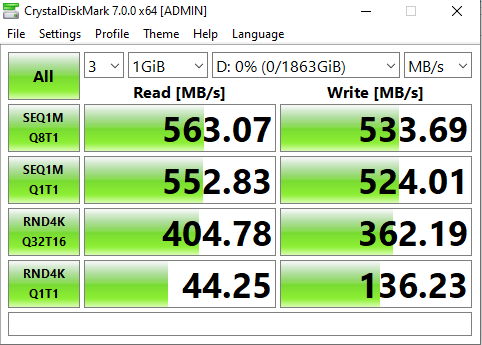CRYSTAL DISK BENCHMARK VER. 7.0.0 x64
Crystal Disk Benchmark is used to measure read and write performance through sampling of random data which is, for the most part, incompressible. Performance is virtually identical, regardless of data sample so we have included only that using random data samples.
THROUGHPUT
IOPS
Through Crystal DiskMark, we get our first look at IOPS which are 98K read and 88K write at low 4K random data transfer, dead on listed specifications.
AS SSD BENCHMARK VER 1.9
The toughest benchmark available for solid state drives is AS SSD as it relies solely on incompressible data samples when testing performance. For the most part, AS SSD tests can be considered the ‘worst case scenario’ in obtaining data transfer speeds and many enthusiasts like AS SSD for their needs. Transfer speeds are displayed on the left with IOPS results on the right.The AS SSD results aren’t as appealing as we might like to see but do get a first look at read and write IOPS which appear to be in the general ball park of listed specs.
ANVIL STORAGE UTILITIES PROFESSIONAL
Anvil’s Storage Utilities (ASU) are the most complete test bed available for the solid state drive today. The benchmark displays test results for, not only throughput but also, IOPS and Disk Access Times. Not only does it have a preset SSD benchmark, but also, it has included such things as endurance testing and threaded I/O read, write and mixed tests, all of which are very simple to understand and use in our benchmark testing.
AJA VIDEO SYSTEM DISK TEST
The AJA Video Systems Disk Test is relatively new to our testing and tests the transfer speed of video files with different resolutions and Codec.
 The SSD Review The Worlds Dedicated SSD Education and Review Resource |
The SSD Review The Worlds Dedicated SSD Education and Review Resource | 


Not sure why Les focused on the warranty period (which is essentially meaningless) and doesn’t point out the higher endurance of Samsung’s latest QLC drive (which is actually important). For example, the Crucial P1 has a 200TBW at 1TB / 400TBW at 2TB vs. the Samsung 870 QVO at 360TBW at 1TB / 720 TBW at 2TB. By any estimation, regardless of the warranty period, the 870 QVO has a better warranty than the equivalent capacity Crucial P1. Same with the Adata SU630 / SU635. Seagate does a little better at 280TBW on their 960GB BarraCuda Q1, but still not as good as the Samsung drive. And it’s also a little strange that he would compare the 3-year warranty period on a QLC drive to the 10-year warranty period on an MLC drive, when every manufacturer has lower ratings on QLC and TLC, than MLC.
Appreciate your comment. I focused on this because 5-years is gaining alot of traction as the industry standard. In my opinion at least, it is a bit ironic since Samsung was the only to have a 10-year warranty some time ago. The great part of owning my own website is I can provide my thoughts without influence I guess. I also tied in my warranty concern with pricing thoughts as well. To qualify your examples, I was hoping for similar. The P1 is an m.2 NVMe drive with a five year warranty and cheaper. The SU630 is last gen and you would be lucky even finding a 1TB. The SU635…currently unavailable and again, old stock. Barracuda Q1 960GB is much much cheaper.
Now…warranty. I can guarantee anyone who has ever had to address a warranty issue wouldn’t agree with your thought that it is essentially meaningless. I actually left warranty support out of the report for the benefit of Samsung.
At the end of the day, I can live with a more expensive SSD OR a lesser warranty, but don’t think that both should be present, especially when the industry standard has been to show confidence in new NAND through warranty. Again thank you for your input.
The TBW for a Crucial P1, as an example is 5 years at 0.1 DWPD vs. the 870 QVO at 3 Years at 0.3 DWPD.
It’s the reason why businesses ignore warranty length in favor of TBW or DWPD (which is essentially warranty period / TBW). Its a more accurate determinant of drive endurance.
Curiously, I don’t find a lot of examples of 5 year warranties on QLC drives. A check on Amazon indicates there aren’t many straight QLC-based client SATA drives for consumers to choose from. Adata is 3 years. Seagate is 3 years. Team Group is 3 years. Addlink is 3 years. Inland is 3 Years. So, if you think 5 years is the standard, you should indicate what products you’re comparing it to.
First off, warranty has always been based on NAND flash memory for the most part. I thought I might check my previous reviews and, of the last 15, 13 were 5-year warranties. The only 3-year warranties were this review and Samsung’s last portable… a 3-year being the norm but not exclusive as we are seeing portables with 5-years now as well. 13 of 15…. There ya go. Further, this is not a business or enterprise SSD.
Lastly DWPD/TBW means absolutely nothing at three years and one day. 99% of consumers buying this drive won’t ever have need to watch either because they would never do anything that might bring either into question. I am certain they are a bit more comfortable with those two extra year warranty though… the industry standard.